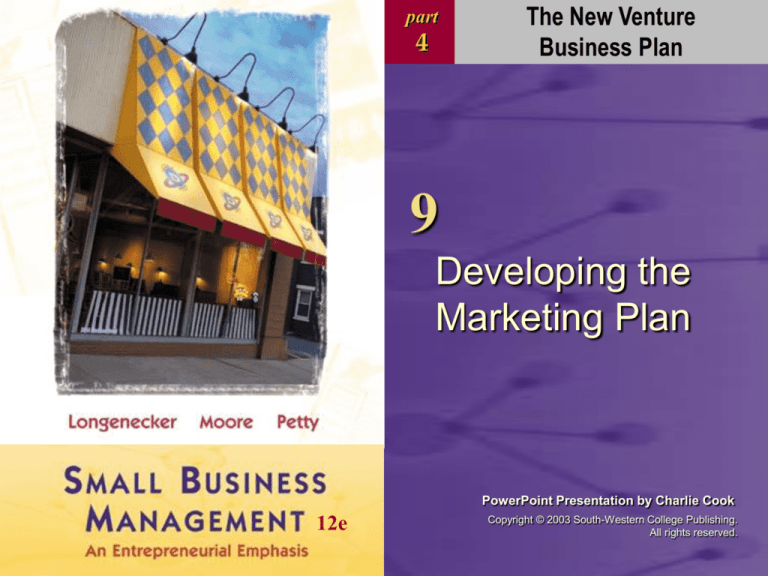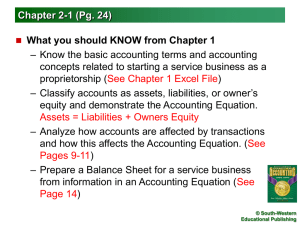
part
4
The New Venture
Business Plan
9
Developing the
Marketing Plan
PowerPoint Presentation by Charlie Cook
12e
Copyright © 2003 South-Western College Publishing.
All rights reserved.
Looking Ahead
After studying this chapter, you should be able to:
1. Describe small business marketing
2. Discuss the nature of the marketing research process.
3. Define market segmentation and its related strategies.
4. Explain the different methods of forecasting sales.
5. Identify the components of a formal marketing plan.
Copyright © by South-Western College Publishing. All rights reserved.
9–2
What is Small Business Marketing?
• Marketing
–Activities directing the flow of goods and services
from producer to consumer or user.
• Small business marketing consists of those
business activities that relate directly to:
–Identifying a target market
–Determining target market potential
–Preparing, communicating, and delivering a
bundle of satisfaction to the target market
Copyright © by South-Western College Publishing. All rights reserved.
9–3
Essential Marketing Activities
• Market Analysis
–An evaluation process that encompasses market
segmentation, marketing research, and sales
forecasting
• Marketing Mix
–The combination of product,
pricing, promotion, and
distribution activities.
Copyright © by South-Western College Publishing. All rights reserved.
9–4
Core Marketing Activities for Small Business
Market Analysis
Marketing Research
Market Segmentation
Sales Forecasting
Target Market
Entrepreneur
Marketing Mix
Distribution
Promotion
Pricing
Product
Entrepreneur
Target Market
Fig. 9-1
Copyright © by South-Western College Publishing. All rights reserved.
9–5
Marketing Philosophies Make a Difference
• Production-Oriented
–Emphasizes development of the product and
production efficiencies over other activities
• Sales-Oriented
–Favors product sales over production efficiencies
and customer preferences
• Consumer-Oriented
–All marketing efforts begin and end with the
customer; focus is on the consumer’s needs—
this philosophy is the most consistent with longterm success of the firm
Copyright © by South-Western College Publishing. All rights reserved.
9–6
Why Firms Fail to Adopt
a Consumer Orientation
• The State of Competition
–With no competition or high demand, firms focus
on production.
• Production Focus of Small Business Managers
–Small business managers tend to have strong
production skills and weak marketing skills.
• Focus on the Present
–Small business managers tend to focus on current
success which is the result of an overemphasis on
selling.
Copyright © by South-Western College Publishing. All rights reserved.
9–7
The Nature of Marketing Research
• Marketing Research
– The gathering, processing, reporting, and
interpreting of market information
• Secondary Data
– Market information that has been previously
compiled by others
• Primary Data
– New market information that is gathered by the
firm conducting the research
Copyright © by South-Western College Publishing. All rights reserved.
9–8
The Nature of Marketing Research
• Steps In the Marketing Research Process
1. Identifying the informational need
Why do we need to know this?
2. Searching for secondary data
Who has researched this topic already?
3. Collecting primary data
Who do we ask and what do we ask them?
4. Interpreting the data
Got the information, now what does it mean?
Copyright © by South-Western College Publishing. All rights reserved.
9–9
Methods for Collecting Primary Data
• Observational Methods • Questioning Methods
–Human
–Mechanical
–Surveys
Mail
Telephone
–Personal interviews
–Experiments
Copyright © by South-Western College Publishing. All rights reserved.
9–10
Understanding Potential Target Markets
• Market
–A group of customers or potential customers who
have purchasing power and unsatisfied needs
• Focus strategy
–A type of competitive strategy in which cost and
marketing strategies are achieved within narrow
market segments
• Market Segmentation
–The division of a market into several smaller
groups with similar needs.
Copyright © by South-Western College Publishing. All rights reserved.
9–11
Ingredients of a Market
Ingredient 1
Customers:
People or
businesses
Ingredient 2
Purchasing
power:
Money/credit
Ingredient 3
Unsatisfied
needs
Copyright © by South-Western College Publishing. All rights reserved.
9–12
Market Segmentation Variables
• Segmentation Variables
–The parameters used to distinguish one form of
market behavior from another for the purpose of
market segmentation
• Benefit Variables
–Specific characteristics that distinguish market
segments according to the benefit sought
• Demographic Variables
–Specific characteristics that describe customers
and their purchasing power
Copyright © by South-Western College Publishing. All rights reserved.
9–13
Types of Market Segmentation Strategies
• Unsegmented Strategy (Mass Marketing)
–A strategy that defines the total market as the
target market
• Multisegmented Strategy
–A strategy that recognizes different preferences of
individual market segments and develops a
unique marketing mix for each
• Single-Segmentation Strategy
–A strategy that recognizes the existence of several
distinct segments but focuses on only the most
profitable segment
Copyright © by South-Western College Publishing. All rights reserved.
9–14
Small Business
(Community Writing Company)
An
Unsegmented
Market
Marketing Mix 1
Product:
Price:
Promotion:
Distribution:
Lead Pencil
$0.79
Television
Extensive
Market
All Potential
Users of a
Writing
Instrument
Fig. 9.3
Copyright © by South-Western College Publishing. All rights reserved.
9–15
Small Business
(Community Writing Company)
Marketing Mix 2
Marketing Mix 1
Marketing Mix 3
Product:
Felt-Tip Pen
Product:
Felt-Tip Pen
Product:
Gold Fountain Pen
Price:
$1.00
Price:
$0.49
Price:
$50.00
Promotion: Professional Magazines
Promotion: Campus Newspapers
Promotion:
Personal Selling
Distribution: Direct from Factory
Distribution: Bookstores
Distribution: Department Stores
Market
Segment A
Students
Market
Segment B
Professors
Market
Segment C
Executives
A Multisegmentation
Market Strategy
Fig. 9.4
Copyright © by South-Western College Publishing. All rights reserved.
9–16
Small Business
(Community Writing Company)
A SingleSegmentation
Market Strategy
Marketing Mix 1
Product:
Price:
Promotion:
Distribution:
Felt-Tip Pen
$0.49
Campus Newspapers
Bookstores
Market
Segment A
Students
Market
Segment B
Professors
Market
Segment C
Executives
Fig. 9.5
Copyright © by South-Western College Publishing. All rights reserved.
9–17
Estimating Market Potential
• The Sales Forecast
–A prediction of how much (in units and/or dollars)
of a product or service will be purchased within a
market during a specified period of time
–An essential component of a business plan that:
Assesses the new venture’s feasibility.
Assists in planning for product
scheduling, setting inventory
levels, and personnel decisions
Copyright © by South-Western College Publishing. All rights reserved.
9–18
Dimensions of Forecasting Difficulty
Conditions That Make
Forecasting Easier
Conditions That Make
Forecasting More Difficult
Established Business
New Venture
Experienced
Entrepreneur/Manager
Forecast
Entrepreneur Familiar with
Forecasting Techniques
Limited Entrepreneurial/
Managerial Experience
Poor Understanding of
Forecasting Techniques
Fig. 9.6
Copyright © by South-Western College Publishing. All rights reserved.
9–19
The Forecasting Process:
Two Dimensions of Forecasting
• The Starting Point
–Breakdown process (chain-ratio method)
Forecasting begins with macro-level variable and works
down to the sales forecast (top-down).
–Buildup process
All potential buyers in various
submarkets are identified and
then the estimated demand is
added up (bottom-up).
Copyright © by South-Western College Publishing. All rights reserved.
9–20
The Forecasting Process:
Two Dimensions of Forecasting (cont’d)
• The Predicting Variable
–Direct forecasting
The use of sales as the predicting variable
–Indirect forecasting
Variables related to sales are used as proxies to project
future sales
Copyright © by South-Western College Publishing. All rights reserved.
9–21
Sales Forecasting with the Breakdown Method
Estimating
Value
Market
Potential*
Linking Variable
Source
1. Idaho state
population
U.S. census of
population
100%
1,000,000
2. State population in
target age
category
Sales & Marketing
Management
Survey of Buying Power
12%
120,000
3. Target age enrolled in colleges
and universities
Idaho Department
of Education
30%
36,000
4. Target age college students
preferring convenience over price
Student survey in a
marketing research class
50%
18,000
5. Convenience-oriented students
likely to purchase new felt-tip pen
within next month
Personal telephone
interview by
entrepreneur
75%
13,500
6. People who say they are likely to
purchase who actually buy
Article in Journal
of Consumer Research
35%
4,725
7. Average number of pens bought
per year
Personal experience of
entrepreneur
4
18,900
SALES FORECAST FOR IDAHO
*Figures in this column, for variables 2-7, are derived by multiplying the percentage or number in the Estimating Value
column times the amount on the previous line of the Market Potential column.
Copyright © by South-Western College Publishing. All rights reserved.
9–22
The Formal Marketing Plan
• Market Analysis
–Customer profile
A description of potential customers in a target market
–Sales forecasts
“most likely,” “pessimistic,” and “optimistic
• The Competition
–Profile of key management personnel
–Overall strengths and weaknesses
–Related products being marketed or tested
–Likelihood of competitors’ entry into target market
Copyright © by South-Western College Publishing. All rights reserved.
9–23
The Formal Marketing Plan (cont’d)
• Marketing Strategy
–Total product and/or service plan
Decisions affecting the total product
–Distribution plan
Decisions regarding product delivery to customers
–Pricing plan
Setting an acceptable value on the product
–Promotional plan
Communicating information to the target market
Copyright © by South-Western College Publishing. All rights reserved.
9–24






